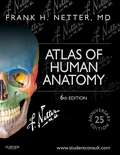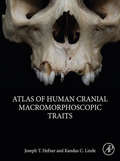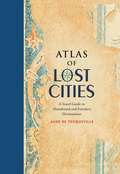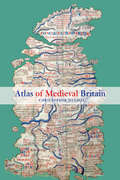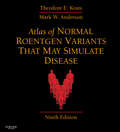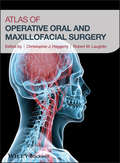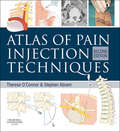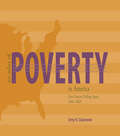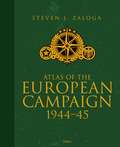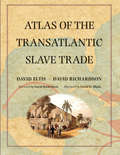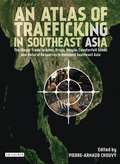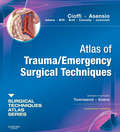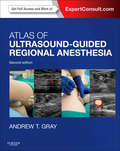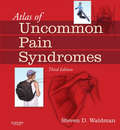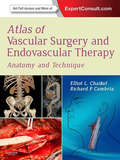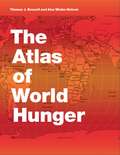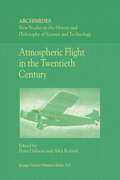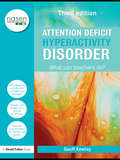- Table View
- List View
Atlas of Human Anatomy, Professional Edition E-Book: Including Student Consult Interactive Ancillaries And Guides (Netter Basic Science)
by Frank H. NetterThe gold standard of excellence for 25 years, Frank H. Netter, MD’s Atlas of Human Anatomy offers unsurpassed depictions of the human body in clear, brilliant detail – all from a clinician’s perspective. With its emphasis on anatomic relationships and clinically relevant views, Dr. Netter’s work provides a coherent, lasting visual vocabulary for understanding anatomy and how it applies to medicine today.Consult this title on your favorite e-reader. Compatible with Kindle®, nook®, and other popular devices. View anatomy from a clinical perspective with hundreds of exquisite, hand-painted illustrations created by pre-eminent medical illustrator Frank H. Netter, MD. Join the global community of medical and healthcare students and professionals who rely on Netter to optimize learning and clarify even the most difficult aspects of human anatomy. Comprehensive labeling uses the international anatomic standard terminology, Terminologia Anatomica, and every aspect of the Atlas is reviewed and overseen by clinical anatomy and anatomy education experts. Netter’s Anatomy Atlas is also available as an app for iPad®.Explore additional unique perspectives of difficult-to-visualize anatomy through all-new paintings by Dr. Carlos Machado, including breast lymph drainage; the pterygopalantine fossa; the middle ear; the path of the internal carotid artery; and the posterior knee, plus additional new plates on arteries of the limbs and new radiologic images.Master challenging structures with visual region-by-region coverage -- including Muscle Table appendices at the end of each Section.
Atlas of Human Cranial Macromorphoscopic Traits
by Joseph T. Hefner Kandus C. LindeAtlas of Human Cranial Macromorphoscopic Traits synthesizes macromorphoscopic traits and their analysis in an accessible manner, providing detailed descriptions and examples of the various character state manifestations intended for use in classrooms, laboratories, and in the field. The volume begins with an outline of the macromorphoscopic dataset, its history, recent modifications to the historical approach, and recent technological and analytical advances. Additional sections cover Nomenclature, Gross Anatomy, Function, Methodology, Line Drawings, Detailed Definitions, Multiple High-resolution Photographs, and Population Variation Data from the Macromorphoscopic Databank (MaMD). The volume concludes with a chapter outlining the statistical analysis of macromorphoscopic data and a summary of the computer programs and reference databases available to forensic anthropologists for the analysis of these data.Provides detailed descriptions, illustrations and high-resolution images of various character state manifestations of seventeen macromorphoscopic traitsApplies to both forensic and bioarcheological researchWritten by the foremost expert on macromorphoscopic trait analysis and estimation of ancestry in forensic anthropology
Atlas of Lost Cities: A Travel Guide to Abandoned and Forsaken Destinations
by Aude de TocquevilleExplore more than forty forsaken urban destinations around the world in a "highly entertaining read . . . for history buffs, mystery fanatics and travel junkies alike" (GoNomad). Cities are mortal, but the traces they leave behind tell a fascinating story. In Atlas of Lost Cities, an accomplished travel writer reveals the rise and fall of notable places, each pithy portrait illuminated by a vintage map that puts armchair explorers right in the scene. Wander with care through: Ancient and legendary places like Pompeii, Teotihuacá and AngkorContemporary wonders like Centralia, a nearly abandoned Pennsylvania town consumed by unquenchable underground fireEerie planned communities like Nova Citas de Kilamba in Angola, where housing, schools, and stores were built for 500,000 people who never cameEpecuen, a tourist town in Argentina that was swallowed by water With each map are fantastical illustrations that help the reader envision these hubs as they were in their prime. A perfect gift for the traveler who believes he or she has seen it all.
Atlas of Medieval Britain
by Christopher DaniellChristopher Daniell's Atlas of Medieval Britain presents a sweeping visual survey of Britain from the Roman occupation to 1485. Annotated throughout with clear commentary, this volume tells the story of the British Isles, and makes visually accessible the varied and often complex world of the Middle Ages. The Atlas depicts the spatial distribution of key events and buildings between 1066 and 1485, as well as providing the relevant Anglo-Saxon background. Charting the main political, administrative and religious features of medieval society, the maps also locate cultural landmarks such as the sites of mystery plays, universities and specific architectural styles. Topics covered include: Iron Age and Roman occupation Anglo-Saxons and Vikings changing political scenarios within England, Scotland, Wales and Ireland religious framework, including diocesan boundaries, monasteries and friaries government, society and economy. Complete with recommended further reading, this volume is an indispensable reference resource for all students of medieval British history.
Atlas of Medieval Britain
by Christopher DaniellChristopher Daniell's Atlas of Medieval Britain presents a sweeping visual survey of Britain from the Roman occupation to 1485. Annotated throughout with clear commentary, this volume tells the story of the British Isles, and makes visually accessible the varied and often complex world of the Middle Ages. The Atlas depicts the spatial distribution of key events and buildings between 1066 and 1485, as well as providing the relevant Anglo-Saxon background. Charting the main political, administrative and religious features of medieval society, the maps also locate cultural landmarks such as the sites of mystery plays, universities and specific architectural styles. Topics covered include: Iron Age and Roman occupation Anglo-Saxons and Vikings changing political scenarios within England, Scotland, Wales and Ireland religious framework, including diocesan boundaries, monasteries and friaries government, society and economy. Complete with recommended further reading, this volume is an indispensable reference resource for all students of medieval British history.
Atlas of Normal Roentgen Variants That May Simulate Disease E-Book
by Theodore E. Keats Mark W. AndersonSeeing is believing with the Atlas of Normal Roentgen Variants That May Simulate Disease, edited by the late Theodore Keats and Mark W. Anderson. Now streamlined into a more concise, portable print format, with a wealth of additional content, this medical reference book's thousands of images capture the roentgenographic presentation of a full range of normal variants and pseudo-lesions that may resemble pathologic conditions, helping you avoid false positives. Consult this title on your favorite e-reader with intuitive search tools and adjustable font sizes. Elsevier eBooks provide instant portable access to your entire library, no matter what device you're using or where you're located. Make the correct diagnosis with hundreds of MR and CT correlations. Recognize the entire spectrum of normal variants with over 6,000 images, the largest collection available on this topic. Prepare for the pitfalls of the oral exam with an easily accessible text that's designed to help you avoid false positives.Find the most essential content more quickly with a much more compact volume that covers only the most important skeletal presentations.
Atlas of Operative Oral and Maxillofacial Surgery
by Robert M. Laughlin Christopher J. HaggertyAtlas of Operative Oral and Maxillofacial Surgery is an innovative, multidisciplinary, contemporary surgical atlas covering core aspects of oral and maxillofacial surgery, head and neck reconstructive surgery and facial cosmetic surgery. The text is constructed as a procedure-based surgical atlas with special emphasis placed on depicting surgical techniques with high-resolution color illustrations and images. Chapters are written by experts in their field and are designed to provide high-yield information pertaining to procedure indications, contraindications, pertinent anatomy, techniques, post-operative management, complications and key points. Each chapter concludes with a detailed photographic case report illustrating pertinent procedure specifics such as locations for incisions, anatomical planes of dissection, key steps in the procedure, radiographs findings and pre- and postoperative photographs.Procedures are organized by sections to include: dentoalveolar and implant surgery, odontogenic head and neck infections, maxillofacial trauma surgery, orthognathic and craniofacial surgery, tempomandibular joint surgery, infections of the head and neck, facial cosmetic surgery, and pathology and reconstructive surgery.The combination of concise text, more than 1,000 color clinical illustrations and images, and case reports makes the Atlas of Operative Oral and Maxillofacial Surgery a key reference to all oral and maxillofacial surgeons, head and neck surgeons, and facial plastic surgeons and will serve as a foundation for residency training, board certification and the recently implemented recertification examinations.
Atlas of Operative Oral and Maxillofacial Surgery
by Robert M. Laughlin Christopher J. HaggertyAtlas of Operative Oral and Maxillofacial Surgery is an innovative, multidisciplinary, contemporary surgical atlas covering core aspects of oral and maxillofacial surgery, head and neck reconstructive surgery and facial cosmetic surgery. The text is constructed as a procedure-based surgical atlas with special emphasis placed on depicting surgical techniques with high-resolution color illustrations and images. Chapters are written by experts in their field and are designed to provide high-yield information pertaining to procedure indications, contraindications, pertinent anatomy, techniques, post-operative management, complications and key points. Each chapter concludes with a detailed photographic case report illustrating pertinent procedure specifics such as locations for incisions, anatomical planes of dissection, key steps in the procedure, radiographs findings and pre- and postoperative photographs.Procedures are organized by sections to include: dentoalveolar and implant surgery, odontogenic head and neck infections, maxillofacial trauma surgery, orthognathic and craniofacial surgery, tempomandibular joint surgery, infections of the head and neck, facial cosmetic surgery, and pathology and reconstructive surgery.The combination of concise text, more than 1,000 color clinical illustrations and images, and case reports makes the Atlas of Operative Oral and Maxillofacial Surgery a key reference to all oral and maxillofacial surgeons, head and neck surgeons, and facial plastic surgeons and will serve as a foundation for residency training, board certification and the recently implemented recertification examinations.
Atlas of Pain Injection Techniques E-Book
by Therese C. O'Connor Stephen E. AbramHere's a highly illustrated practical guide with easy to follow descriptions of pain injection techniques. It will give special advice on how to achieve a successful block and how to avoid and manage potential problems. The techniques will be described in a systematic and easy to use way. Each description of the injection will be accompanied by figures demonstrating the surface anatomy, patient position, needle puncture site and movement of the needle in relation to anatomyh. Where necessary further figures will be used to show dye injections and successful blocks.Uses concise bulleted text with important factors highlighted throughout for ease of understanding and assimilation. Shows how to perform each injection technique step-by-step with comprehensive illustrations (photographs, line drawings, radiologic images) Techniques are grouped together in a logical and easy to follow manner with the same format being used for each block Offers solutions to actual clinical problems and highlights potential pitfalls in both diagnosis and treatment.. Covers a broad scope of clinical practice for use by both beginners and experts.
An Atlas of Poverty in America: One Nation, Pulling Apart 1960–2003
by Amy GlasmeierPersistant poverty has long been one of America's most pressing and intractable problems. According to some estimates, by 2003, almost twenty-five percent of the America's countries had per-capita incomes below one half the national average, high unemployment, low labour force participation rates, and a high dependency on government transfer payments - all measures of economic distress. An Atlas of Poverty in America shows how and where America's regional development patterns have become more uneven, and graphically illustrates the increasing number of communities falling behind the national economic average. Readers will be able to use this Atlas to see how major events and trends have impacted the scope and extent of American poverty in the past half-century:economic globalization, the rise of the sunbelt, decline of the welfare state, and the civil rights movement. Also includes 195 colour maps.
An Atlas of Poverty in America: One Nation, Pulling Apart 1960–2003
by Amy GlasmeierPersistant poverty has long been one of America's most pressing and intractable problems. According to some estimates, by 2003, almost twenty-five percent of the America's countries had per-capita incomes below one half the national average, high unemployment, low labour force participation rates, and a high dependency on government transfer payments - all measures of economic distress. An Atlas of Poverty in America shows how and where America's regional development patterns have become more uneven, and graphically illustrates the increasing number of communities falling behind the national economic average. Readers will be able to use this Atlas to see how major events and trends have impacted the scope and extent of American poverty in the past half-century:economic globalization, the rise of the sunbelt, decline of the welfare state, and the civil rights movement. Also includes 195 colour maps.
Atlas of the Blitzkrieg: 1939–41
by Robert KirchubelIn September 1939, Nazi Germany launched its infamous Blitzkrieg invasion of Poland, bringing about the outbreak of World War II. Faced with highly tactical and accelerated attacks aimed at disrupting the line of defence and encircling vulnerable troops, Allied forces broke under pressure. Within the space of a year, France had been invaded and occupied, while the forces of Great Britain had retreated headlong back across the Channel. Further campaigns in the air and at sea sought to subdue the British Isles, while more lightning-fast attacks in 1941 overran Yugoslavia and Greece, leaving the bulk of Continental Europe under Nazi control. Though the dominance of the Blitzkrieg method was to be challenged in the latter part of the war, as Allied forces found methods of disrupting the attacks and dominating the battlefields, its unparalleled success in the early years of the conflict brought Europe to its knees. Featuring 107 detailed maps, this impressive atlas shows, in intricate detail, the fighting and physical challenges faced by the German attackers and Allied defenders. This will be a treasure for World War II enthusiasts and collectors alike.
Atlas of the European Campaign: 1944–45
by Steven J. ZalogaIn June 1944 the Allies opened the long-awaited second front against Nazi Germany on the beaches of Normandy, and this was to be the start of a long struggle throughout Western Europe for the Allied forces in the face of stiff German resistance. The European Theatre was where the bulk of the Allied forces were committed in the struggle against Nazi Germany. It saw some of the most famous battles and operations of the war – Normandy, Market Garden, the Battle of the Bulge – as the Allies sought to liberate Western Europe in the face of bitter and hard-fought German resistance. From the beaches of D-Day through to the final battles in war-ravaged Germany, the war across the breadth and depth of Western Europe is brought to life through scores of carefully researched and intricately detailed maps.
Atlas of the Transatlantic Slave Trade (The Lewis Walpole Series in Eighteenth-Century Culture and History)
by David Eltis David RichardsonA monumental work, decades in the making: the first atlas to illustrate the entire scope of the transatlantic slave trade Between 1501 and 1867, the transatlantic slave trade claimed an estimated 12.5 million Africans and involved almost every country with an Atlantic coastline. In this extraordinary book, two leading historians have created the first comprehensive, up-to-date atlas on this 350-year history of kidnapping and coercion. It features nearly 200 maps, especially created for the volume, that explore every detail of the African slave traffic to the New World. The atlas is based on an online database (www.slavevoyages.org) with records on nearly 35,000 slaving voyages—roughly 80 percent of all such voyages ever made. Using maps, David Eltis and David Richardson show which nations participated in the slave trade, where the ships involved were outfitted, where the captives boarded ship, and where they were landed in the Americas, as well as the experience of the transatlantic voyage and the geographic dimensions of the eventual abolition of the traffic. Accompanying the maps are illustrations and contemporary literary selections, including poems, letters, and diary entries, intended to enhance readers’ understanding of the human story underlying the trade from its inception to its end.This groundbreaking work provides the fullest possible picture of the extent and inhumanity of one of the largest forced migrations in history.
An Atlas of Trafficking in Southeast Asia: The Illegal Trade in Arms, Drugs, People, Counterfeit Goods and Natural Resources in Mainland Southeast Asia (International Library Of Human Geography Ser.)
by Pierre-Arnaud ChouvyMainland Southeast Asia is one of the world's key regions for the smuggling and trafficking of illegal goods. Armed conflict in the region has spurred an international trade in small arms, and organized nuclear smuggling rings are now believed to operate as well. Human trafficking is widespread, with children being especially vulnerable either for slave labour or sexual exploitation. The region is being flooded with contraband and counterfeit goods such as pirated movies, designer label clothes and currency, especially US dollars, whilst antiques, oil and medicinal drugs - counterfeit as well as authentic ones - are also being smuggled.While such activity has been drawing increased attention, the scope, nature and mechanisms of smuggling and trafficking across the region are far from understood. Even less is known about the various synergies that may exist between the different trafficking activities. An Atlas of Trafficking in Southeast Asia brings together a team of key researchers and cartographic specialists to provide a unique overview of the major forms of illegal trafficking in the region. The contributors have been drawn from a range of disciplines, reflecting the complex reality of this diverse and thriving illegal economy. Geographer Pierre-Arnaud Chouvy provides a history of the drug trafficking routes in and out of the Golden Triangle, whose opium and heroin networks have played such a significant role in both the regional and global history. Anthropologist David Feingold, focuses on human smuggling and trafficking, a highly complex trade with many causes and consequences, whilst political scientist David Capie examines the illegal trade in small arms. There has been impressive rhetoric about the need to tackle the illicit arms trade but much less in the way of practical action. Southeast Asia has the highest rate of deforestation of any major tropical region, whilst wildlife is currently being extracted at six times the sustainable rate. Vanda Felbab-Brown, also a political scientist, examines the key interrelated topics of illegal logging and wildlife trafficking. Finally, journalist Bertil Lintner surveys the trade in counterfeit goods and contraband, two thriving activities in mainland Southeast Asia. Accompanying the text is a unique series of thirty-two full-colour maps. These maps have been especially drawn for the atlas and detail the trafficking hubs, counter-trafficking facilities and border status for each of the trafficking activities. Political, historical, topographic, ecological and linguistic regional maps are also included. An Atlas of Trafficking in Southeast Asia sheds valuable light on the complex and shadowy world of one of the key regions for illegal trading. An unparalleled reference resource, it will be welcomed by professionals and academics across a wide range of disciplines.
Atlas of Trauma/ Emergency Surgical Techniques E-Book: A Volume in the Surgical Techniques Atlas Series
by William Cioffi Juan A. AsensioAtlas of Trauma/Emergency Surgical Techniques, a title in the Surgical Techniques Atlas Series, presents state-of-the-art updates on the full range of trauma and emergency surgical techniques performed today. Drs. Cioffi and Asensio, along with numerous other internationally recognized general surgeons, offer you step-by-step advice along with full-color illustrations and photographs to help you expand your repertoire and hone your clinical skills.Easily review normal anatomy and visualize the step-by-step progression of each emergency surgery procedure thanks to more than 330 detailed anatomic line drawings and clinical photographs.Avoid complications with pearls and pitfalls from the authors for every surgical technique.Master the key variations and nuances for a full range of emergency techniques. A highly formatted approach provides step-by-step instructions with bulleted "how-to" guidance for each procedure.
Atlas of Ultrasound-Guided Regional Anesthesia E-Book: Expert Consult - Online
by Andrew T. GraySafely and effectively perform regional nerve blocks with Atlas of Ultrasound-Guided Regional Anesthesia, 2nd Edition. Using a wealth of step-by-step videos and images, Dr. Andrew T. Gray shows you how to use the latest methods to improve the success rate of these techniques.Consult this title on your favorite e-reader with intuitive search tools and adjustable font sizes. Elsevier eBooks provide instant portable access to your entire library, no matter what device youre using or where you're located. Master essential techniques through step-by-step videos demonstrating paravertebral block, transversus abdominis block, psoas nerve block, subgluteal nerve block, and more.Test your knowledge and prepare for the ABA exam with board-style review questions.Ensure correct needle placement with numerous 3-D and long-axis views that clearly depict surrounding structures.Update your skills with completely rewritten chapters on Infraclavicular, Neuraxial, and Cervical Plexus Blocks as well as entirely new chapters on Fascia Iliaca, Anterior Sciatic, Transversus Abdominis Plane (TAP), and Stellate Ganglion Blocks.Review a full range of nerve block techniques in an easy-to-follow, step-by-step manner using new quick-reference summary tables.View author-narrated videos and access the complete contents online at www.expertconsult.com; assess your knowledge with the aid of a new "turn labels off" feature for each image.
Atlas of Uncommon Pain Syndromes E-Book
by Steven D. WaldmanObtain optimal diagnostic results from the field’s foremost pain expert! Noted authority Steven D. Waldman, MD, JD, offers complete, concise, and highly visual guidance on the diagnosis of more than 100 uncommon pain syndromes less frequently encountered in daily practice. Vivid illustrations depict the physical symptoms and anatomy of each pain site as well as key imaging findings involving techniques such as MRI, CT, and conventional radiograph. It’s the effective, easy-access resource you need to evaluate uncommon pain syndromes and sharpen your diagnostic skills.Uses a consistent format to explore each pain syndrome, progressing through diagnostic codes • signs and symptoms • physical findings • laboratory and radiographic testing • treatment options • and clinical pearls...enabling you to find the information you need fast. Explores side effects and complications, helping you to avoid common diagnostic pitfalls and obtain the best results. Includes ICD-9 codes to facilitate accurate billing. Serves as a companion volume to Dr. Waldman’s Atlas of Common Pain Syndromes, 2nd Edition —equipping you with well-rounded guidance for the clinical challenges you’re likely to face.Features updated chapters throughout, and over 30 new chapters including Surpaorbital Neuralgia • Charlin’s Syndrome • Vail’s Syndrome • Hyoid Syndrome • Subacromial Impingement Syndrome • Thrower’s Elbow Syndrome • and Triangular Fibrocartilage Tera Syndrome—to keep you abreast of the conditions presenting in today’s practice. Presents over 350 illustrations—175 in full color and more than 100 new to this edition—as well as x-rays, CTs, and MRIs, helping you to confirm your diagnoses and confidently implement techniques.
Atlas of Vascular Surgery and Endovascular Therapy E-Book: Anatomy and Technique
by Elliot L. Chaikof Richard P. CambriaFeaturing an easy-to-access, highly visual approach, Atlas of Vascular Surgery and Endovascular Therapy offers the comprehensive, step-by-step guidance you need to achieve optimal outcomes in the treatment of venous disorders. Covering the full range of diseases/disorders most important to vascular surgeons, this full-color atlas presents over 100 common and complex procedures, including open and endovascular techniques, with an emphasis on anatomy and imaging studies as they apply to each technique.Consult this title on your favorite e-reader, conduct rapid searches, and adjust font sizes for optimal readability. Know what to do and expect with comprehensive coverage of almost every procedure you might need to perform. Find answers fast thanks to a consistent and logical chapter structure. (Indications, Surgical Anatomy, Preoperative Considerations, Operative Steps, Postoperative Considerations, Pearls & Pitfalls, and References) Review key techniques prior to performing surgery. Clinical images capture key moments in procedures including: surgical repair of a suprarenal aortic aneurysm; surgical repair of thoracoabdominal aortic aneurysm; endovascular treatment of aneurysms of the juxtarenal and pararenal aorta; surgical exposure and harvest of the femoropopliteal vein; and endovascular treatment of aortic arch vessels, subclavian and axillary artery. Visualize every procedure thanks to more than 1,000 full-color illustrations; including procedural photos and beautifully illustrated drawings that highlight the relevant anatomy and techniques in specific treatments. Prevent and plan for complications prior to a procedure thanks to a step-by-step approach to each procedure accompanied by relevant imaging studies. Glean all essential, up-to-date, need-to-know information about hot topics including: management of peripheral arterial disease; aortic aneurysms/aortic dissection; lower extremities/critical limb ischemia; and infra-inguinal occlusive disease.
The Atlas of World Hunger
by Thomas J. Bassett Alex Winter-NelsonEarlier this year, President Obama declared one of his top priorities to be “making sure that people are able to get enough to eat.” The United States spends about five billion dollars on food aid and related programs each year, but still, both domestically and internationally, millions of people are hungry. In 2006, the Food and Agricultural Organization of the United Nations counted 850 million hungry people worldwide, but as food prices soared, an additional 100 million or more who were vulnerable succumbed to food insecurity. If hunger were simply a matter of food production, no one would go without. There is more than enough food produced annually to provide every living person with a healthy diet, yet so many suffer from food shortages, unsafe water, and malnutrition every year. That’s because hunger is a complex political, economic, and ecological phenomenon. The interplay of these forces produces a geography of hunger that Thomas J. Bassett and Alex Winter-Nelson illuminate in this empowering book. The Atlas of World Hunger uses a conceptual framework informed by geography and agricultural economics to present a hunger index that combines food availability, household access, and nutritional outcomes into a single tool—one that delivers a fuller understanding of the scope of global hunger, its underlying mechanisms, and the ways in which the goals for ending hunger can be achieved. The first depiction of the geography of hunger worldwide, the Atlas will be an important resource for teachers, students, and anyone else interested in understanding the geography and causes of hunger. This knowledge, the authors argue, is a critical first step toward eliminating unnecessary suffering in a world of plenty.
The Atlas of World Hunger
by Thomas J. Bassett Alex Winter-NelsonEarlier this year, President Obama declared one of his top priorities to be “making sure that people are able to get enough to eat.” The United States spends about five billion dollars on food aid and related programs each year, but still, both domestically and internationally, millions of people are hungry. In 2006, the Food and Agricultural Organization of the United Nations counted 850 million hungry people worldwide, but as food prices soared, an additional 100 million or more who were vulnerable succumbed to food insecurity. If hunger were simply a matter of food production, no one would go without. There is more than enough food produced annually to provide every living person with a healthy diet, yet so many suffer from food shortages, unsafe water, and malnutrition every year. That’s because hunger is a complex political, economic, and ecological phenomenon. The interplay of these forces produces a geography of hunger that Thomas J. Bassett and Alex Winter-Nelson illuminate in this empowering book. The Atlas of World Hunger uses a conceptual framework informed by geography and agricultural economics to present a hunger index that combines food availability, household access, and nutritional outcomes into a single tool—one that delivers a fuller understanding of the scope of global hunger, its underlying mechanisms, and the ways in which the goals for ending hunger can be achieved. The first depiction of the geography of hunger worldwide, the Atlas will be an important resource for teachers, students, and anyone else interested in understanding the geography and causes of hunger. This knowledge, the authors argue, is a critical first step toward eliminating unnecessary suffering in a world of plenty.
Atmospheric Flight in the Twentieth Century (Archimedes #3)
by Alex Roland, Peter GalisonAll technologies differ from one another. They are as varied as humanity's interaction with the physical world. Even people attempting to do the same thing produce multiple technologies. For example, John H. White discovered more than l 1000 patents in the 19th century for locomotive smokestacks. Yet all technologies are processes by which humans seek to control their physical environment and bend nature to their purposes. All technologies are alike. The tension between likeness and difference runs through this collection of papers. All focus on atmospheric flight, a twentieth-century phenomenon. But they approach the topic from different disciplinary perspectives. They ask disparate questions. And they work from distinct agendas. Collectively they help to explain what is different about aviation - how it differs from other technologies and how flight itself has varied from one time and place to another. The importance of this topic is manifest. Flight is one of the defining technologies of the twentieth century. Jay David Bolter argues in Turing's Man that certain technologies in certain ages have had the power not only to transform society but also to shape the way in which people understand their relationship with the physical world. "A defining technology," says Bolter, "resembles a magnifying glass, which collects and focuses seemingly disparate ideas in a culture into one bright, sometimes piercing ray." 2 Flight has done that for the twentieth century.
Attention Deficit Hyperactivity Disorder: What Can Teachers Do? (nasen spotlight)
by Geoff KewleyIs Attention Deficit Hyperactivity Disorder a ‘made-up’ term? Is it simply an excuse for bad behaviour? How do children with ADHD really experience school? This practical teacher’s guide dispels all the myths and gets down to the facts about ADHD. It explores the nitty-gritty of what you need to know in order to help the children in your class to cope with this complex condition. This fully revised second edition gives an overview of the disorder based on the broad internationally recognised approach to ADHD, which takes account of its biological as well as environmental elements. It includes: real-life classroom scenarios and case studies of specific children; practical management strategies for both teachers and parents; an exploration of prevailing attitudes to ADHD; advice on initial diagnosis and ongoing assessment. Packed full of no-nonsense advice and tips, this book will help you adopt the educational strategies and behaviour management approaches that are best suited to each individual child. It also explores the use of alternative treatments, such as psychological and psychiatric strategies, medication, counselling, coaching and changes to diet. Children who have ADHD can often experience school failure, expulsion and emotional, behavioural and social problems. By demystifying the disorder and its coexisting conditions, this book will help you to understand and manage ADHD, enabling you to offer the children you teach a more positive future.
Attention Deficit Hyperactivity Disorder: What Can Teachers Do? (nasen spotlight)
by Geoff KewleyIs Attention Deficit Hyperactivity Disorder a ‘made-up’ term? Is it simply an excuse for bad behaviour? How do children with ADHD really experience school? This practical teacher’s guide dispels all the myths and gets down to the facts about ADHD. It explores the nitty-gritty of what you need to know in order to help the children in your class to cope with this complex condition. This fully revised second edition gives an overview of the disorder based on the broad internationally recognised approach to ADHD, which takes account of its biological as well as environmental elements. It includes: real-life classroom scenarios and case studies of specific children; practical management strategies for both teachers and parents; an exploration of prevailing attitudes to ADHD; advice on initial diagnosis and ongoing assessment. Packed full of no-nonsense advice and tips, this book will help you adopt the educational strategies and behaviour management approaches that are best suited to each individual child. It also explores the use of alternative treatments, such as psychological and psychiatric strategies, medication, counselling, coaching and changes to diet. Children who have ADHD can often experience school failure, expulsion and emotional, behavioural and social problems. By demystifying the disorder and its coexisting conditions, this book will help you to understand and manage ADHD, enabling you to offer the children you teach a more positive future.
Attitudes and Changing Contexts (Synthese Library #332)
by Robert van RooijIn this book, the author defends a unified externalists account of propositional attitudes and reference, and formalizes this view within possible world semantics. He establishes a link between philosophical analyses of intentionality and reference, and formal semantic theories of discourse representation and context change. The relation between belief change and the semantic analyses of conditional sentences and evidential (knowledge) and buletic (desire) propositional attitudes is discussed extensively.
